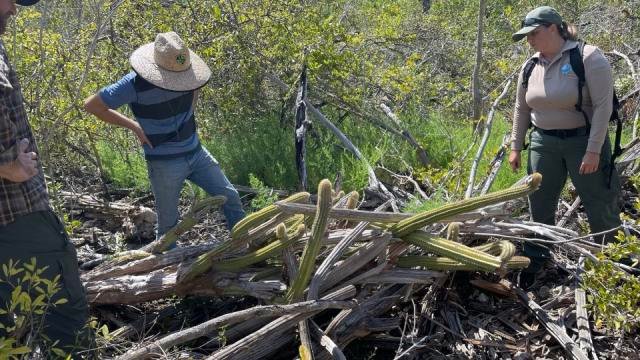Secret ‘sky island’ rainforest saved by new discoveries
Perched on a remote mountain top and surrounded by lowlands, Mabu is what's known as a "sky island" and is the largest rainforest

Roosted on a far off peak and encompassed by marshes, Mabu’s known as a “sky island” and is the biggest rainforest in southern Africa. BBC climate reporter Jonah Fisher went to Mabu with a group of researchers who have found many new species there, assisting with persuading Mozambique to safeguard it.
“Allow me to get my enchanted spoon,” Dr Gimo Daniel says happily.
Secret ‘sky island’ rainforest saved by new discoveries: It’s difficult to envision anybody taking more get a kick out of their work than the 36-year-old Mozambican creepy crawly master.
We’re squatted around a little opening in the soil not a long way from our camp in the focal point of Mabu backwoods. Dr Daniel’s central goal, similar to that of nearly everybody on our undertaking, is to find things that science has not seen previously.
Fertilizer insects are Dr Daniel’s strength and he laughs as he takes out a major plastic tub of snare – his own dung.
The smell is as you’d anticipate. Impactful and difficult to disregard.
Dr Daniel lets me know that he has proactively found what he accepts are 15 new types of compost bugs.
“They can smell it up to 50 meters from here, so they come as quick as possible,” he says. ” It’s informal breakfast.”
A long time back, Mabu was confidential to everything except local people.
It was ‘found’ for the rest of the world by Prof Julian Bayliss in 2004. A wayfarer and scientist who currently lives in north Grains, he was reviewing satellite pictures of northern Mozambique when he ran over a formerly obscure dim green fix.
A first campaign the next year affirmed that in spite of the fact that local people had been hunting in the woods it was in unquestionably great shape and its size at 75 square kilometers made Mabu the biggest single block of rainforest in southern Africa.
“I was like – good gracious – this is exceptional,” Prof Bayliss reviews.
Secret ‘sky island’ rainforest saved by new discoveries: In early undertakings to Mabu, one of which I joined in 2009 while functioning as a BBC reporter in southern Africa, Prof Bayliss was at the front of a ‘dash for unheard of wealth’ of disclosures, rapidly tracking down a few new types of chameleon, snake and butterfly.
In all Prof Bayliss says they’ve tracked down somewhere around 25 new species, and that is not in any event, counting the waste bugs, a large number of which actually should be formally acknowledged.
What makes Mabu so unique is its geology. A medium height rainforest, it distends over Mozambique’s swamps, makes it successfully a ‘sky island’.
That implies a large portion of the creatures and bugs that live there have absolutely no chance of meeting and reproducing with different populaces, expanding the possibilities of them developing in seclusion into something extraordinary and new to science.
Mabu was to a limited extent safeguarded by Mozambique’s long history of nationwide conflict. The longest of which finished in 1992. It was additionally helped by the way that arriving is simply so hard.
Subsequent to driving five hours along country roads the setting up camp stuff, food and gear is all stacked on to the backs and heads of in excess of sixty doormen.
While we, and the researchers, changed our strolling boots and dropped hydration salts in our water bottles, the doormen, a significant number of them wearing just flipflops, walked up Mount Mabu’s lofty slants.
One of the first to find something new is Erica Tovela, a freshwater fish master from Mozambique’s Regular History Historical center. In the stream that goes through camp she gets a sort of little catfish she’s not seen previously.
“I trust that we have another species for this area,” she says cheerfully as she holds up a transparent pack of dead fish. ( They will be saved in formaldehyde for additional examination and correlation with other comparable species). ” Amazing. It will be the main new species for me.”
The course of conclusively recognizing another species can require years. It includes composing a friend evaluated paper in a diary in which the distinctions between the new revelation and its nearest family members are illustrated and acknowledged by different researchers.
The following stage for Ms Tovela is to get the DNA of her fish broke down and definite portrayals and pictures coursed. Also, what may be the name?
Secret ‘sky island’ rainforest saved by new discoveries: “It ought to be something mabuensis,” she says. ” It’s a decent approach to saying we have one explicit animal varieties that is from Mabu. “The huge well evolved creatures that once possessed it like lions, rhinos and bison have all been pursued out, in all probability for food during the conflict. Deforestation has likewise caused significant damage, however not as gravely as different backwoods in southern Africa.
“It’s entirely noticeable that timberlands (in southern Africa) that that I’ve been to only 15 to quite a while back have now vanished, cut down for the overwhelming majority various reasons,” says Prof Ara Monadjem, a specialist in little warm blooded creatures from the College of Eswatini, who was on the excursion.
At Mabu the deforestation has so far been restricted however local people are surely hunting. Camera traps show trackers conveying creatures they’ve gotten and we see actual snares produced using vehicle springs set simply off the tracks through the woodland.
And yet types of more modest vertebrates are likewise being found. They incorporated a horseshoe bat called Rhinolophus mabuensis and a bantam musk wench which researchers are still during the time spent naming and depicting.
Not every person on the undertaking is searching for new species. Bird specialists Claire Spottiswoode and Calum Cohen have an unmistakable mission. To find proof that one of Africa’s most uncommon birds is as yet alive.
The Namuli apalis just lives at elevation and there are fears that a blend of the obliteration of woods somewhere else and warming temperatures are pushing the little yellow and dark bird towards elimination.
“Environmental change frequently has these impacts that are difficult to foresee,” Callan Cohen makes sense of bringing up that occasionally hotter temperatures support snake movement, and that implies more homes and chicks go under assault.
Attempting to find the unique case includes playing it a recording of a Namuli apalis through a Bluetooth speaker and afterward holding on to check whether any answer.








